Apple nutrition in Himachal Pradesh
As first seen in the Orchardist, December 2018
Mike Nelson, Horticultural Consultant Fruition Horticulture, Nelson
Plant & Food Research have been engaged for a three-year term to supply experts along with Fruition Horticulture, AgFirst Engineering and Applied Research and Technologies. The team provides training and advice around orchard management practices and plant protection methods.
Terraced planting
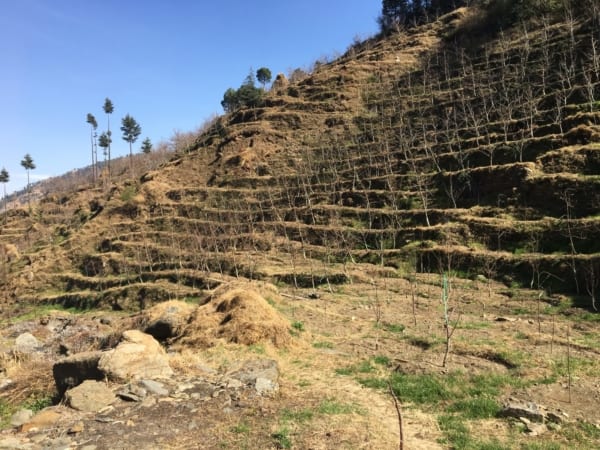 Historically Red delicious is the main cultivar grown on seedling rootsocks. The industry grows about 40 million cartons with average production of 6 T/ha involving more than 100,000 growers – many very small scale down to about 50 trees. Consequently, giving a value per Ha has little meaning, with rates of fertiliser given as a rate per tree. There are few flat areas in the State so most plantings are on terraces on steep hillsides. Rows are often curved which makes construction of any support structure difficult. There is now a push to introduce new cultivars on clonal rootstocks and the use of drip irrigation. Virtually all production is marketed domestically.
Historically Red delicious is the main cultivar grown on seedling rootsocks. The industry grows about 40 million cartons with average production of 6 T/ha involving more than 100,000 growers – many very small scale down to about 50 trees. Consequently, giving a value per Ha has little meaning, with rates of fertiliser given as a rate per tree. There are few flat areas in the State so most plantings are on terraces on steep hillsides. Rows are often curved which makes construction of any support structure difficult. There is now a push to introduce new cultivars on clonal rootstocks and the use of drip irrigation. Virtually all production is marketed domestically.
This article describes some of the nutrient management practices in Himachal Pradesh
Viewing this industry gives a good insight to where we have come from in our own nutrient management practices and highlights the reasons why we do what we do. Such as, timely trace element applications and foliar sprays, and tracking of soil and foliage nutrient levels.
Photo 1: Bark measles likely from manganese toxicity caused by low pH
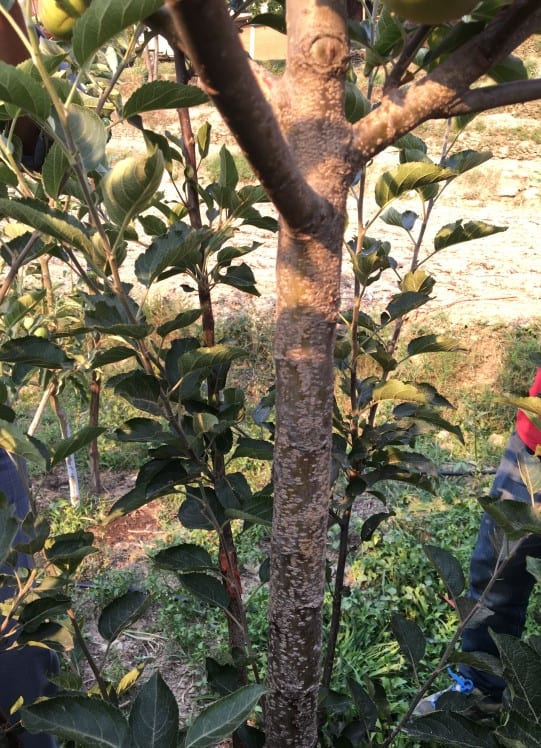 Soil testing has not been a common activity in most orchards in Himachal Pradesh. However, the project has funded and promoted a large increase in the number of blocks tested. In one region where 70 blocks were tested there was a wide variation in soil pH. More than half the blocks tested had a pH that was out of the optimum range of 5.8 to 6.8. With 24% of blocks below (acidic) the optimum pH of 5.8 and a surprising 31% of blocks above the optimum pH of 6.8, sixteen blocks of the seventy above a pH of 7.2. This gives a huge opportunity for improving the performance of these orchard blocks. Maintaining correct soil pH ensures that there is optimum nutrient availability and soil biological activity. Low pH can make some nutrients such as manganese and aluminium highly soluble leading to toxic levels in the plant and conversely too high a pH can make some nutrients insoluble and become deficient. Highly soluble manganese can result in toxicity symptoms such as ‘bark measles’ seen in Photo 1.
Soil testing has not been a common activity in most orchards in Himachal Pradesh. However, the project has funded and promoted a large increase in the number of blocks tested. In one region where 70 blocks were tested there was a wide variation in soil pH. More than half the blocks tested had a pH that was out of the optimum range of 5.8 to 6.8. With 24% of blocks below (acidic) the optimum pH of 5.8 and a surprising 31% of blocks above the optimum pH of 6.8, sixteen blocks of the seventy above a pH of 7.2. This gives a huge opportunity for improving the performance of these orchard blocks. Maintaining correct soil pH ensures that there is optimum nutrient availability and soil biological activity. Low pH can make some nutrients such as manganese and aluminium highly soluble leading to toxic levels in the plant and conversely too high a pH can make some nutrients insoluble and become deficient. Highly soluble manganese can result in toxicity symptoms such as ‘bark measles’ seen in Photo 1.
Figure 1: Nutrient availability at varying pH levels
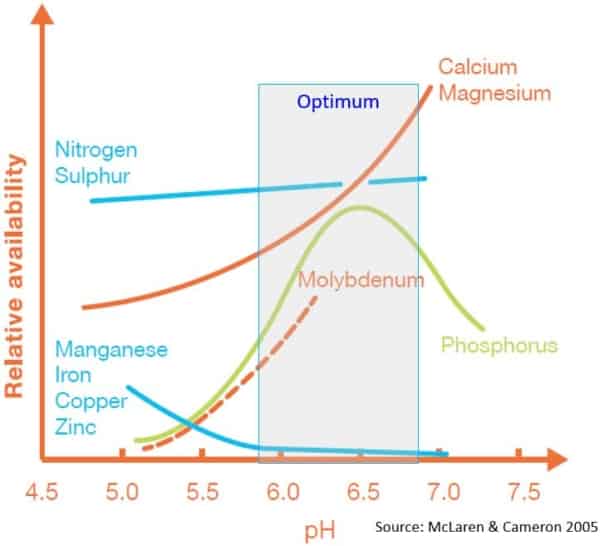 Even in NZ , while there is a good understanding of raising a low pH with lime, growers are less conscious of the potential problems of higher pH’s. At a pH of 7, manganese is becoming insoluble and unavailable (along with zinc, copper and iron) and at 7.2 is virtually insoluble (Figure 1) resulting in leaf deficiency symptoms of pale interveinal areas. Symptoms are similar to magnesium deficiency except the fine leaf veins tend to remain green. While leaf testing may show low plant manganese levels, and the response would be to apply a foliar spray with manganese, the underlying cause is high pH, which should be eased back. We occasionally see this problem in N.Z. and highlights the first stage of good nutrient management is maintaining a correct soil pH.
Even in NZ , while there is a good understanding of raising a low pH with lime, growers are less conscious of the potential problems of higher pH’s. At a pH of 7, manganese is becoming insoluble and unavailable (along with zinc, copper and iron) and at 7.2 is virtually insoluble (Figure 1) resulting in leaf deficiency symptoms of pale interveinal areas. Symptoms are similar to magnesium deficiency except the fine leaf veins tend to remain green. While leaf testing may show low plant manganese levels, and the response would be to apply a foliar spray with manganese, the underlying cause is high pH, which should be eased back. We occasionally see this problem in N.Z. and highlights the first stage of good nutrient management is maintaining a correct soil pH.
Photo 2: Showing widely spaced seedling trees with annual application of farm yard manure applied in the ‘tree basin’
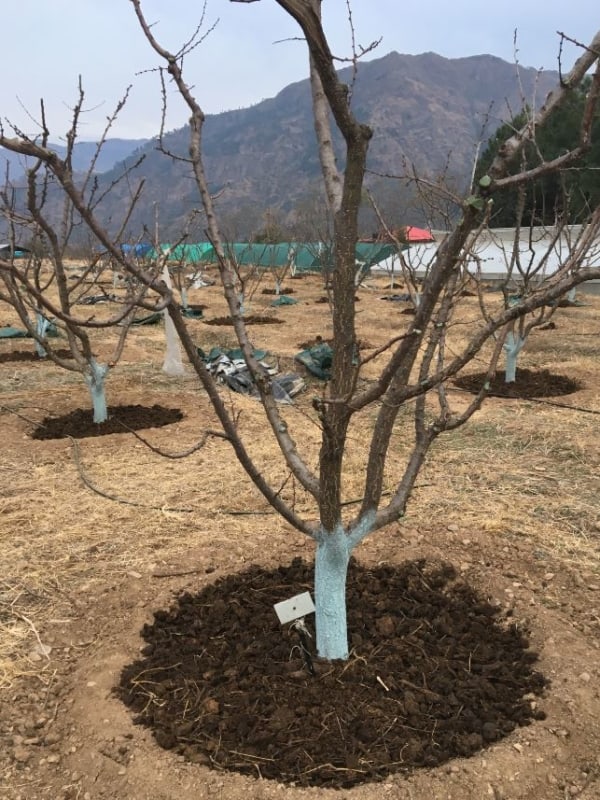 Of course, with nutrients and fertiliser, everyone would like it to be as simple as possible, and in Himachal Pradesh, with many small holdings, it is no exception. They have developed a system of prescribing fertiliser based on tree age. For an established six year old high density planting the recommendation is 210 gm/m2 of urea, 300 gm/m2 of super phosphate and 210 gm/m2 of potassium chloride. The application area under trees is called the tree basin which tends to be a circular cultivated area around the tree, often with with mounding around the perimeter to contain water, a bit like a miniature border dyke style of irrigation. This equates to very high rates of N P K. For nitrogen this would be in the range 230kg N/ha compared to about 50 – 70kg N/ha applied in NZ. For phosphate approximately 65 kg/ha is recommended compared to 10 – 20 kg/ha applied as maintenance dressings in NZ. The amount of potassium applied is relatively high as well at 250 kg K/ha. These values may be appropriate when building fertility but applied continuedly are likely to be excess to plant requirements, particularly nitrogen, and detrimental to good fruit set, fruit colour and quality.
Of course, with nutrients and fertiliser, everyone would like it to be as simple as possible, and in Himachal Pradesh, with many small holdings, it is no exception. They have developed a system of prescribing fertiliser based on tree age. For an established six year old high density planting the recommendation is 210 gm/m2 of urea, 300 gm/m2 of super phosphate and 210 gm/m2 of potassium chloride. The application area under trees is called the tree basin which tends to be a circular cultivated area around the tree, often with with mounding around the perimeter to contain water, a bit like a miniature border dyke style of irrigation. This equates to very high rates of N P K. For nitrogen this would be in the range 230kg N/ha compared to about 50 – 70kg N/ha applied in NZ. For phosphate approximately 65 kg/ha is recommended compared to 10 – 20 kg/ha applied as maintenance dressings in NZ. The amount of potassium applied is relatively high as well at 250 kg K/ha. These values may be appropriate when building fertility but applied continuedly are likely to be excess to plant requirements, particularly nitrogen, and detrimental to good fruit set, fruit colour and quality.
Fertiliser is not the only nutrient source. Many of the orchards are part of a mixed farm with animals and other crops suppling a ready source of composted animal manure which is applied, at anything up to 5 kg/m2 as a mulch and slow release nutrient source (Photo 2). While this is very good for soil health, mineralisation of nutrients particularly nitrogen is likely to be high late in the season when it is warm and the monsoon weather is contributing ample soil moisture, at a period when we would like to see limited availability of nitrogen, to assist with fruit colour development and quality.
Boron deficiency was seen on some orchards. Fruit symptoms are seen early in the season with dark pitting, progressing through to cracks and deformed fruit (Photos 3 – 5). Which is not to be confused with bitter pit, caused by lack of calcium, which is seen late in the season. This deficiency can easily be avoided with foliar boron applications pre-flowering and soil applications.
Photos 3-5: Boron deficiency symptoms
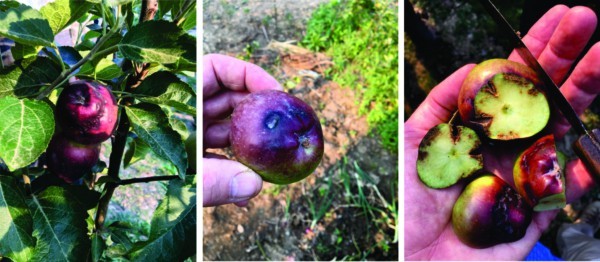
Also, of interest is the wide spread use of Potassium chloride. We use the sulphate form of potassium, as potassium chloride is considered ‘risky’ with many horticultural crops due to the risk of chloride toxicity. However, I have yet to see any signs of chloride toxicity even at higher rates used.
As this industry moves to newer cultivars nutrient management will be become even more important. Growers and advisors will gain a better understanding of soil and tissue testing, and plant observation to make better nutrient decisions rather than one size fits all approach.